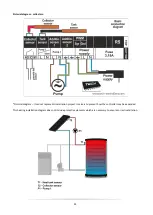
21
•
Receiver activation temperature
- This parameter concerns the activation of the tank-receiver pump. The pump
is activated after the upper tank sensor reaches this value (provided that the temperature of the receiver is lower
than the temperature of the upper tank sensor). If the temperature of the upper tank sensor drops below the
activation temperature minus the heat receiver hysteresis, the pump is deactivated until the tank temperature
increases.
•
Heat receiver hysteresis
- This parameter applies both to the receiver maximum temperature and the receiver
activation temperature and the parameter is described in detail above.
3.5.
PUMPS
•
Pump revolutions - regulated or constant
- Using this function the user defines the mode of the pump operation:
constant revolutions, when the pump operates at all times at full power (when enabled) or regulated revolutions.
In the case of regulated revolutions, the user should adjust several additional parameters (see below).
•
Maximum collector temperature
- Using this setting the user declares the value of the collector maximum alarm
temperature at which the pump may be damaged. This temperature should be adjusted according to the
collector technical specification. Due to the phenomenon of glycol "gelation" at high temperatures and the risk
of damaging the solar pump, the pump is deactivated after reaching the maximum alarm temperature (the
controller switches to
Collector overheat
mode
)
.
•
Solar pump deactivation delta
- This function determines the difference between the collector temperature and
the tank temperature at which the pump is deactivated (so as not to cool down the tank).
•
Solar pump activation delta
- This function determines the difference between the collector temperature and
the tank temperature at which the pump is enabled (this is the pump activation threshold).
•
Gear coefficient
- This parameter is available only if regulated revolutions option is selected. When the
conditions for the pump activation are met, it is initially activated at minimum speed (
solar pump work
minimum
). Then the pump speed increases according to this coefficient which determines the difference (°C)
between the collector temperature and the tank temperature at which the pump speeds up by 10%. The gear
coefficient applies only to the pump operating revolutions, namely the value of revolutions within the limits of
the solar pump work minimum (0% for the gear coefficient) as well as the solar pump work maximum (100% for
the gear coefficient). The greater the difference between the collector temperature and the tank temperature,
the higher the pump speed.
Example:
If the gear coefficient value is 3, each 3
o
C difference between the tank temperature and the collector
temperature results in 10% increase in pump speed
The table below contains examples of the coefficient values and its results.
Gear coefficient 3 Gear coefficient 4 Gear coefficient 5 Gear coefficient 6
Pump working revolutions
Δ
value
(collector temp. –
tank temp.)
Δ3
Δ4
Δ5
Δ6
10%
Δ6
Δ8
Δ10
Δ12
20%
Δ9
Δ12
Δ15
Δ18
30%
Δ12
Δ16
Δ20
Δ24
40%
Δ15
Δ20
Δ25
Δ30
50%












































